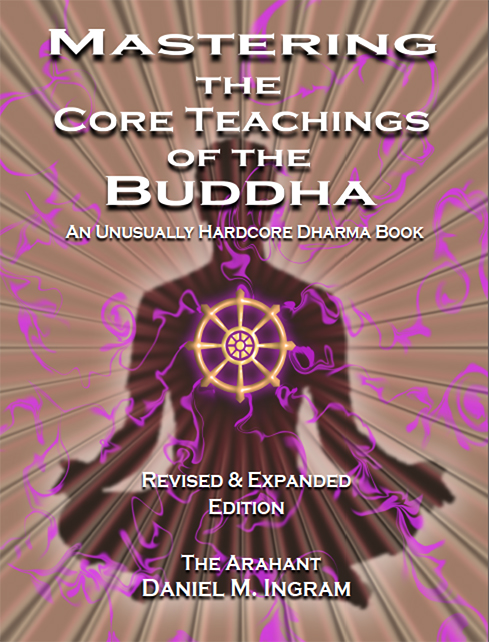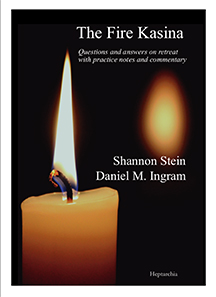12. Conformity
← 11. Equanimity | 13. Change of Lineage →
Conformity means that we suddenly flash onto a way of perceiving the whole of our experiential reality completely, directly, and perfectly clearly. This stage lasts only one moment and never recurs until we attain the next stage of enlightenment. The same is true of the following two stages. Stages twelve through fourteen (Conformity, Change of Lineage, and Path) are the three moments of the first entrance to transcendent ultimate reality (stage fifteen or Fruition) through one of the three doors (there is a whole section on those shortly). In subsequent attainments of Fruition at the same “path” (or level of enlightenment), during the stage of Review, the three moments before Fruition are no longer called Conformity, Change of Lineage, and Path. We will return to this in the more extensive treatment of these three stages in the chapter “The Three Doors”.
In the first edition of MCTB, this section on Conformity was very short. However, I realized that this would be a great place to add something I call “The Hierarchy of Vipassana Practice”, as this culminates in Conformity Knowledge. Here is a practical guide on how to adjust our practice depending on what is going on and what we are capable of, as well as urging us to keep working to reach the next rung of the ladder of practice, skill, and understanding.
At our best, we attain to Conformity Knowledge, in which we effortlessly, naturally, simultaneously, and totally comprehend two of the three characteristics of our entire sense field including space, consciousness, and everything else in that volume as an integrated whole. Bill Hamilton used to describe Conformity as the moment when all of the centers of attention in the brain suddenly synchronize and converge perfectly on one complete moment, and his description holds up in practice.
However, I will go back to the bottom, which is where most start and often return, and work back up from there, hopefully to illustrate that wherever you are, all you have to do is just get up one level and then work from there. This will hopefully make it more workable. Going from least developed to most developed:
1)Not trying to practice, lost in our stuff, spacing out, mindfulness weak.
2)Mindfulness weak, lost in our stuff, but at least attempting some technique or just basic attention to what is happening at times, even if we can’t actually do it for long. People spend whole retreats at this level, unfortunately.
3)Better able to practice, albeit with frequent interruptions, and to follow basic instructions such as noting, body scanning, or whatever you are trying to do. I’ll go non-technique-specific here, as this is a guide to the essence of the thing: basically any technique, object, or posture that moves you up this hierarchy and keeps you there is what matters, and nothing about the specifics of your object of attention or how you are attending to it is important as long as it serves that fundamental goal.
4)Able to do a specific vipassana technique or set of techniques that allows you to stay with aspects of your sensate reality as it presents with few interruptions.
5)Able to apply those techniques or practices uninterruptedly.
6)Able to perceive directly the three characteristics of objects in the center of attention consistently and directly regardless of whether we are using a more specific technique. In short, if you can do this, for that time, however long that lasts, whether you use a more formal technique is irrelevant.
7)Able to perceive directly and continuously the sensations that make up the coarse background components also in that same light of strong, direct vipassana awareness, meaning direct comprehension of the three characteristics of not only the foreground objects, but also those in the background or periphery, such as rapture, equanimity, fear, doubt, frustration, analysis, expectation, and other sensations, as well as other objects as they arise, such as thoughts and the component sensations of feelings, as well as the primary object or objects (assuming we at this point are still using primary objects, which is not necessary).
8)Able to do #7 very well and then add core processes, such as the sensations that seem to make up attention itself, intention itself, memory itself, questioning, effort, surrender, subtle fear, space, consciousness, and everything that seems to be subject or observer or self all the way through the skull, neck, chest, abdomen, and all of space such that nothing is excluded from this comprehensive, cutting, piercing, instantly comprehending clarity that is synchronized with all phenomena (or is just about to be).
9)Able to do #8 naturally, effortlessly, and clearly due to diligent efforts to write that wiring on the mind as our new baseline default mode of perception.
10)We are back to where we started with Conformity Knowledge: we comprehend simultaneously two of the three characteristics of our entire sense field, including space, consciousness, and everything else in that volume as an integrated whole, and so attain Conformity, and then Change of Lineage, Path, and Fruition (to be detailed shortly). That’s what we are shooting for if we are at least going for stream entry, and it even works well for the sort of complete mindfulness that effects higher paths.
Keeping this hierarchy in mind, many questions are answered either directly or with small amounts of additional information:
Q: Does it matter what object I use?
A: Only if that object at that moment in time helps you at least stay at the higher of the lower few levels of the hierarchy and hopefully progress up them. You don’t want to switch objects and techniques too often, as this will usually lead to a lack of depth, particularly if you are a beginner and have mastered no techniques or objects. You do want to have the metacognitive awareness to be able to frequently adjust how you are using your mind and to recognize where you are along this hierarchy, such that you are able to continually improve your game.
Q: Does it matter if my concentration is narrowly focused or broad?
A: Conformity Knowledge can take any object and work with it, but it must take the complete sensate reality of that moment. If your whole moment is very exclusively focused or refined, it can work with that. If your whole moment is widely focused and broadly inclusive of the sense doors, it can work with that. Since all you have to do is comprehend the three characteristics of our sum total reality for three moments, Conformity could take as object a refined object if you haven’t become automatically fluent enough with other objects to attain to Conformity Knowledge using them. For example, if you can get your attention focused exclusively on the breath such that the breath becomes your whole reality, and comprehend the sensations that compose it along with the attention-focusing apparatus, as that is all there is, that’s all you need to understand. If you can’t get attention that focused or refined but have attained through diligent work a natural fluency in a wider array of other sensations, then broader attention will do just fine.
Q: Does it matter what technique I use?
A: I would give different advice to beginning, intermediate, and advanced meditators. Beginners can benefit from more structure and technique. Once you have some solid skills, I would say scramble up the hierarchy however you can, using any object you can, and whatever dose it takes to get there, changing objects, focuses, techniques, postures, or whatever other factors need to be changed if those help you move higher and stay there. This is the pragmatist’s approach rather than the dogmatic traditionalist’s approach to vipassana. If a dogmatic and traditional approach moves you up the hierarchy, there is no conflict at all. If your dogmatic and traditional approach is not working at that moment, meditation period, hour, month, or year, try switching things around, preferably with the help of good guidance if available, to see what does move you up a rung.
Q: When should I stop noting and just pay attention?
A: You can definitely stop when at that particular time you are at stage six or higher, but you could also continue as long as it doesn’t slow you down or restrict your ability to comprehend whatever arises in its rich and comprehensive entirety. See Mahasi’s Practical Insight Meditation for more good advice on this point. Read it very carefully.
Q: Which technique is better: noting, body scanning, Zen koan training, or what?
A: Whatever helps you progress or at least stabilize beyond the lower levels of that hierarchy at that time. Techniques take time to learn well, so continuously abandoning one poorly-learned and poorly-applied technique for another poorly-learned and poorly-applied technique will not do any good, but if you have learned a few techniques well, then anything that works goes. Realize that this is for most people a very dynamic and nonlinear progression, with many ascents and descents along the ranks of the hierarchy, and learning how to shift focus or approach at the right time is a learned skill that requires constant vigilance and practice, but having the basic goals in mind should help guide you.
For instance, say we decided to use noting practice, and had gotten to insight stage two, Cause and Effect, with steady, slow noting, but then bad back pain began to derail our attempts at noting in stage three, Three Characteristics, during which time we fell back to lousy practice. We might reflect: “Ah, I am no longer able to do slow noting, at least I should try to do slow noting, and perhaps mindfully adopt a different posture for the time being that isn’t so painful.”
Or, we might have been doing noting up through Three Characteristics, but then began to notice energetic phenomena, such as heat and kundalini stuff, that were fluctuating too quickly to note well, at which point we might think, “Ah, I was really good at blasting through the A&P using more Goenka-style body scanning on a previous retreat and know how to do that, maybe I will give that a try, as it worked well before.”
Or, we might have been rockin’ it in the A&P by rapidly and directly perceiving fast vibrations and tingling interference patterns, but when we got to Dissolution we noticed that our practice was completely derailed and we were just spacing out. We might reflect, “Ah, whereas before I was rockin’ it in the A&P, now my practice has fallen to the bottom of the barrel, and perhaps attempting to do slow noting to build back up to more direct methods when I can would be better than floundering.” Good plan!
Or, we might be high up in Equanimity and yet not be able to land a Fruition. We might ask ourselves, “What core process, subtle background or foreground sensations, or other patterns of core experience that really seem to be ‘me’ have not yet been brought into the clear light of direct comprehension in the way I have done for so many objects?” In this way, we see what we are missing and, having learned to see those objects naturally and without any effort at all, we land it.
Working thus, we get a sense of how we can adjust our practice to accommodate what is happening and keep us riding the waves of change that vipassana in all its forms can throw at us.

